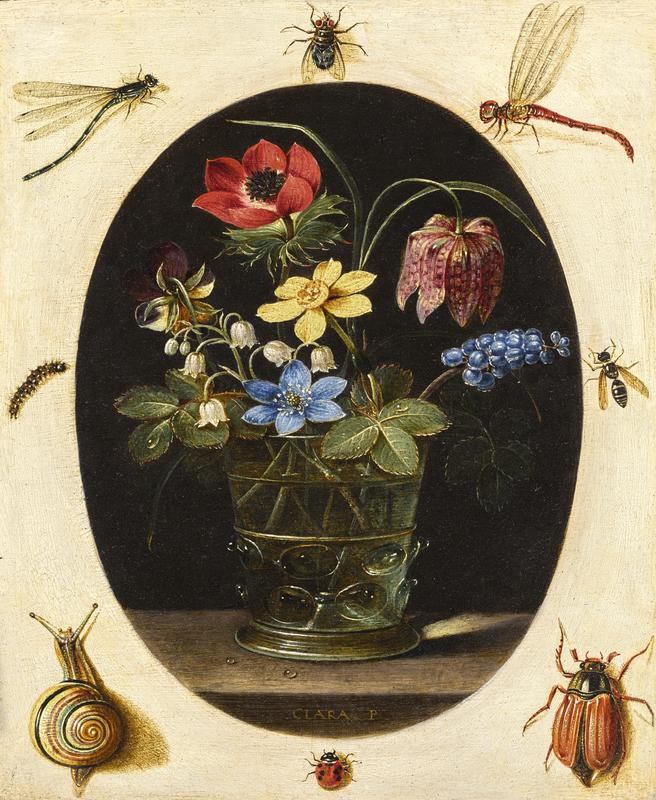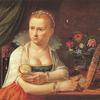More about Still Life with Flowers Surrounded by Insects and a Snail

Sr. Contributor
Still life painting, once considered the lowest genre, developed in the Netherlands due to increased demand from the growing merchant class.
Clara Peeters’ Still Life with Flowers Surrounded by Insects and a Snail features an arrangement of flowers held inside a roemer glass, surrounded by a trompe l’oeil frame consisting of eight symmetrically arranged insects. There are many kinds of still lifes in the still life genre, and this one is classified as a still life with flora and fauna. Still lifes of this nature were often created not only to convey the vanitas message of the transience of life, but also for scientific study. However, scientific study for the Dutch was not a secular pursuit like it is today, but was deeply tied to religion. Biology, or the study of life, was seen as a way to prove the subservience of nature to man, hence the existence of God. Insects, like the ones featured in this painting, were central to this study, often featured in still life paintings and collected as curios in cabinets of curiosities all over Europe. In paintings, insects also had a religious meaning, representing earthly bonds.
Bouquets, like the ones featured here, symbolized divine love. Although this seems like it could have been painted from Peeters’ kitchen counter, still lifes were carefully curated paintings, constructed compositions of the artist’s imagination. Flowers are from different seasons and at different stages of bloom, making it impossible for the arrangements found in these paintings to exist in reality. The wilting flowers also are a reminder of physical death. Flowers had other hidden meanings, too, used to convey messages in paintings of all genres. White flowers, like the lily-of-the-valley in this painting, were symbols of purity, often associated with the Virgin Mary, ever present in scenes like the Annunciation. A classic red rose alludes to the shedding of Christ’s blood and its thorns, of course, to the crown of thorns worn during the crucifixion. The color red symbolizes the suffering of Christ and God’s love, like in the red anemone featured here, while blue symbolizes the maternal grief of Mary, like in the grape hyacinth.
This piece is painted with painstaking detail, representing the impossible combination of flowers and insects as convincingly as possible. Flowers were bought and sold in the Low Countries at enormous prices and quantities, especially during the period of 'Tulip Mania' when the speculation of the tulip flower led to an economic crisis. Both the insects and flowers, some found locally and others abroad, are reflective of the burgeoning trade economy of the Netherlands and the technological invention of the microscope which would make the observation of organisms such as the insect possible. The eclectic nature of these paintings is thus a product of 17th century “modernity” during the Dutch Golden Age.
Peeters signs her painting in the lower middle center, on the table with the bouquet, as “CLARA P”. Women were often associated with still-life painting, which was considered the lowest genre. However, female artists like Peeters, Rachel Ruysch, and Marie van Oosterwijck, were able to achieve commercial success through the increased demand for paintings of this genre by the emerging Dutch merchant middle class during the Dutch Golden Age. They were well-known in their time, gaining international renown despite their lack of access to formal art education and institutions, which essentially barred them from gaining commissions for paintings of the more prestigious genres.
Sources
- Carlson, Olivia. “Microcosms: An Examination of Insects in 17th-century Dutch Still Lives.” Scholarly Horizons: University of Minnesota, Morris Undergraduate Journal: Vol. 6 : Iss. 2 , Article 1. https://digitalcommons.morris.umn.edu/horizons/vol6/iss2/1
- Nastiuk, Elena. “Flowers as a symbol in art.” Arthive. Accessed Jan 30, 2019. https://arthive.com/encyclopedia/1742~Flower_as_symbol_in_art.
- Petit, David A. “An Overview of Dutch and French Still Life Painting.” Art Education, Vol. 41, No. 5 (Sept 1998): 14-19.
- Pound, Cath. “Secret Symbols in Still-Life Painting.” BBC. BBC Global News Ltd, March 19, 2018. http://www.bbc.com/culture/story/20180318-secret-symbols-in-still-life-….
- “Still Life with Flowers in a Glass Vase Surrounded by Insects and a Snail.” Sotheby’s. Accessed Jan 30, 2019. http://www.sothebys.com/en/auctions/ecatalogue/2018/old-masters-evening….











